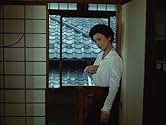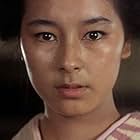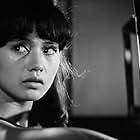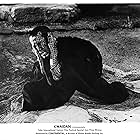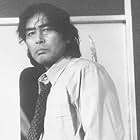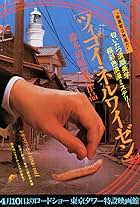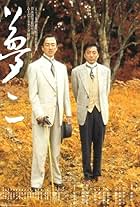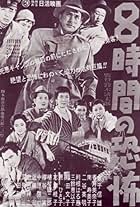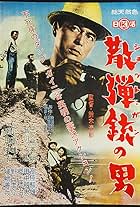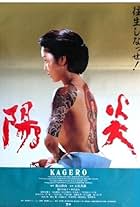A 1920s playwright meets a beautiful woman who may be the ghost of his patron's deceased wife.A 1920s playwright meets a beautiful woman who may be the ghost of his patron's deceased wife.A 1920s playwright meets a beautiful woman who may be the ghost of his patron's deceased wife.
- Awards
- 4 wins & 5 nominations
Michiyo Yasuda
- Shinako
- (as Michiyo Ohkusu)
Bsaku Satô
- Station employee
- (as Bsaku Satoh)
- Director
- Writers
- All cast & crew
- Production, box office & more at IMDbPro
Storyline
Featured review
Kagerô-za is the second part of director Suzuki Seijun's Taisho Roman Trilogy and comes around only one year after the unconventional comeback success of Zigeunerweisen. This movie is based upon a novel by Izumi Kyoka. The film tells the story of a naive young playwright who feels attracted to a mysterious married woman who mysteriously appears into and disappears out of his life . He however soon finds out that her rich husband has a second wife of German origin whose blonde hair and blue eyes can only be seen under the moonlight. There are however rumours in town that the foreign wife is actually dead and has come back as a ghostly apparition. Caught between guilt and passion, the protagonist must decide whether he should defy traditional conventions and be with the lady he desires or commit a double suicide to escape from the nightmarish circumstances.
This film convinces with its overall mysterious and sinister atmosphere. Despite an absence of shocking scenes, Kagerô-za has a creepy vibe from start to finish. Viewers will wonder whether the whole story is fiction or reality or perhaps something in between. The theme of the contrast between traditional Japanese values and radical modernization is perfectly represented by the two female lead characters. The confusion, fear and loss caused by this clash is portrayed brilliantly by the protagonist. This movie doesn't offer any answers, solutions or strategies to these challenges, conflicts and problems. Viewers are thus invited to imagine possible outcomes and discuss these with other cineasts. This movie thus appeals to an intellectual audience and takes its viewers very seriously. In this regard, this film is pleasantly old-fashioned but might be a struggle for younger audiences at first contact.
There are however several reasons why this interesting movie nonetheless deserves a lower rating than its immediate predecessor Zigeunerweisen. First and foremost, Kagerô-za uses several stylistic devices from the predecessor such as its general atmosphere, parts of its plot and the general themes. This movie thus feels at times predictable, repetitive and uninspired. Even the camera angles and soundtrack offer numerous similarities. Viewers might feel that this film can't really stand on its own. Another significant issue is the film's challenging length of one hundred thirty-nine minutes. This film feels plodding in its middle section and is at least half an hour too long. Director Suzuki Seijun honestly did much better jobs when the studio limited his films to running times around ninety minutes in the sixties. His independent films from the eighties onwards should have benefited from some suggestions, overviews and cuts from studio executives to be easier to digest. The advantage is that his films from this era really represent the director's creativity, ideas and opinions without any filter but the notable downside is that these movies are at times overbearingly long, suffocatingly self-important and uncomfortably uncompromising.
As you can read, viewers will need a lot of empathy, patience and time to appreciate Suzuki Seijun's Taisho Roman Trilogy to the fullest. Kagerô-za convinces with interesting characters, beautiful settings and mysterious story. The downsides are its repetitive elements, excessive length and slow pace. This movie is thus recommended to admirers of Suzuki Seijun's later career and cineasts appreciating romantic dramas with supernatural elements. If you already feel that this movie might not suit your preferences by reading this review, then you simply shouldn't waste your time and can skip this feature without any relevant regrets. If you feel however intrigued by this review and generally appreciate films that walk off the beaten path, then you might want to give Kagerô-za a chance.
This film convinces with its overall mysterious and sinister atmosphere. Despite an absence of shocking scenes, Kagerô-za has a creepy vibe from start to finish. Viewers will wonder whether the whole story is fiction or reality or perhaps something in between. The theme of the contrast between traditional Japanese values and radical modernization is perfectly represented by the two female lead characters. The confusion, fear and loss caused by this clash is portrayed brilliantly by the protagonist. This movie doesn't offer any answers, solutions or strategies to these challenges, conflicts and problems. Viewers are thus invited to imagine possible outcomes and discuss these with other cineasts. This movie thus appeals to an intellectual audience and takes its viewers very seriously. In this regard, this film is pleasantly old-fashioned but might be a struggle for younger audiences at first contact.
There are however several reasons why this interesting movie nonetheless deserves a lower rating than its immediate predecessor Zigeunerweisen. First and foremost, Kagerô-za uses several stylistic devices from the predecessor such as its general atmosphere, parts of its plot and the general themes. This movie thus feels at times predictable, repetitive and uninspired. Even the camera angles and soundtrack offer numerous similarities. Viewers might feel that this film can't really stand on its own. Another significant issue is the film's challenging length of one hundred thirty-nine minutes. This film feels plodding in its middle section and is at least half an hour too long. Director Suzuki Seijun honestly did much better jobs when the studio limited his films to running times around ninety minutes in the sixties. His independent films from the eighties onwards should have benefited from some suggestions, overviews and cuts from studio executives to be easier to digest. The advantage is that his films from this era really represent the director's creativity, ideas and opinions without any filter but the notable downside is that these movies are at times overbearingly long, suffocatingly self-important and uncomfortably uncompromising.
As you can read, viewers will need a lot of empathy, patience and time to appreciate Suzuki Seijun's Taisho Roman Trilogy to the fullest. Kagerô-za convinces with interesting characters, beautiful settings and mysterious story. The downsides are its repetitive elements, excessive length and slow pace. This movie is thus recommended to admirers of Suzuki Seijun's later career and cineasts appreciating romantic dramas with supernatural elements. If you already feel that this movie might not suit your preferences by reading this review, then you simply shouldn't waste your time and can skip this feature without any relevant regrets. If you feel however intrigued by this review and generally appreciate films that walk off the beaten path, then you might want to give Kagerô-za a chance.
- How long is Kagero-za?Powered by Alexa
Details
- Release date
- Country of origin
- Language
- Also known as
- Heat-Haze Theatre
- Production company
- See more company credits at IMDbPro
Contribute to this page
Suggest an edit or add missing content









